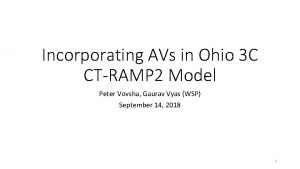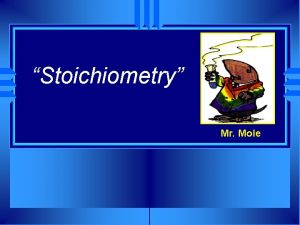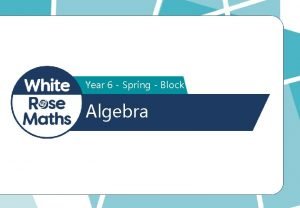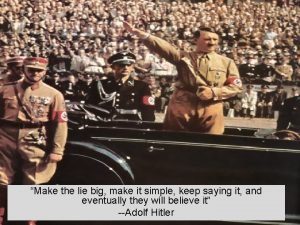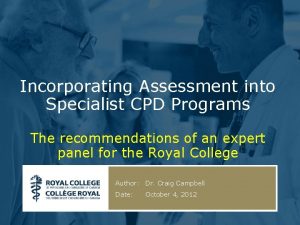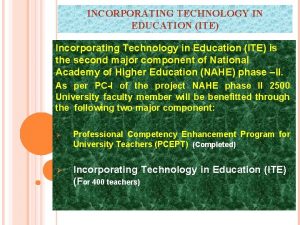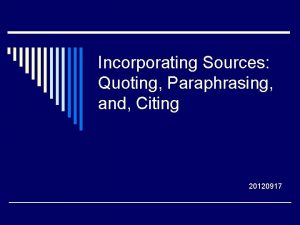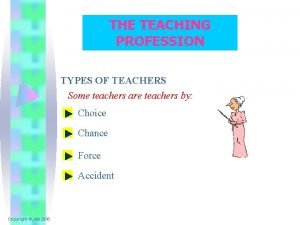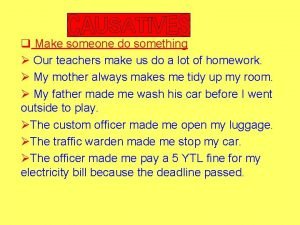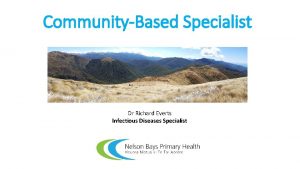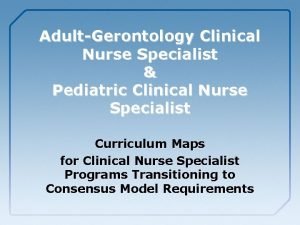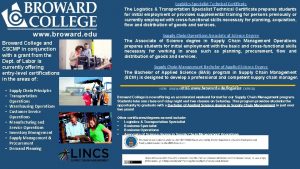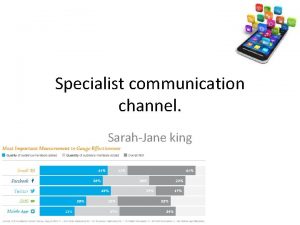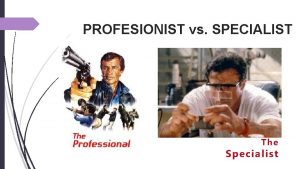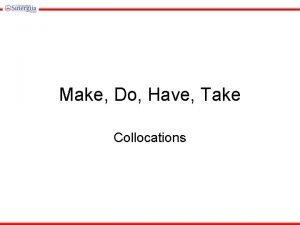Make Some Space Incorporating Specialist Teachers Into the



























- Slides: 27


Make Some Space Incorporating Specialist Teachers Into the PYP Planner Keri Harrison & Ashleigh Woodward

Introduction & Agenda • Who We Are • Where We Are In Space and Time • How We Organize Ourselves

What Does The IB Say? Standard A #3

What else do they say? Standard C 1

They say more? Standard B 2 #3 a and #4 Standard C 1#3

• • Looking at the Arts and PSPE S&S. . . There is a lot of information there! Perhaps because these are the most common of the single-subjects? For example, “It is acknowledged that in many schools, single-subject teachers take responsibility for different arts areas. It is vital that these teachers see themselves primarily as PYP teachers who teach arts, and in so doing contribute to the overall outcomes of a transdisciplinary programme. To ensure a cohesive educational experience for students, a PYP school has a responsibility to make sure that there are regular opportunities for collaboration between single-subject teachers and homeroom/classroom teachers. This collaboration includes the development and review of the school’s programme of inquiry, as well as planning, teaching, assessing and reflecting on individual units of inquiry. ” (Arts Scope & Sequence )

Inquiry-Based, Authentic Programming

Specialist Teacher Integration Strategies #1 Developing or supporting a unit within the programme of inquiry: “Whenever appropriate, single-subject teachers should be involved in collaborative planning to plan, teach, assess and reflect on the units of inquiry. ” (mod. AS&S)

Specialist Teacher Integration Strategies #2 Preparing for or following on from a unit within the programme of inquiry: “The direct teaching of single-subject teachers in a unit of inquiry may not always be feasible but, where appropriate, introductory or follow-up learning experiences may be useful to help students make connections between the different aspects of the curriculum. Single-subject teachers may plan and teach activities or experiences that prepare students for participation in a unit of inquiry. Following on from a unit, students may demonstrate their understanding of the central idea in a single-subject context. ” (mod. AS&S)

Specialist Teacher Integration Strategies #3 Independent inquiry: “There may be times when teachers will be teaching aspects of single-subjects independent of the programme of inquiry using purposeful inquiry. At such times, teachers should structure their teaching and learning through the use of the PYP planning process. Teachers should ensure that authentic connections are made while maintaining the integrity and essential character or learning in, through and about specialist subjects. If undertaking an inquiry outside the programme of inquiry, teachers should still recognize that the same philosophy and pedagogy must underpin their planning of the subject. ” (mod. AS&S)

Looking At Planners. . . You may be a part of a homeroom teacher’s unit of inquiry or create your own, but both use the planner. Some effective ways of ‘connecting’ include through: • Central ideas • Lines of inquiry • Key concepts

Connecting Through Central Ideas: • Consider • ‘opening up’ your central idea. For example, change “Art” to “The Arts” or “experiments” to “experiences. ” The following are some central ideas from IB documents and other planners. As we cycle through them, discuss how the single subjects at your school might be able to connect to these central ideas.

Central Ideas #1 and #2 1. Systems provide a common framework we can use to understand our world. 2. We use and respond to signs and symbols in different ways.

Central Ideas #3 and #4 3. Identifying, using and describing patterns helps us to make sense of the world we live in. 4. Conflict and peace affect relationships within communities.

Central Ideas #5 and #6 5. Making good choices helps to keep us healthy. 6. Decisions are related to the needs of the individual or the community.

Central Idea Follow-Up What did you notice about those central ideas? Why were we able to connect some singlesubjects better than others?

Connecting Lines of Inquiry • These too can be ‘broadened’ to explore bigger ideas or deeper • • concepts. Lines of inquiry simply must be appropriate to the development level and interests of the students (MTPYPH). They may be conceptually based, which is a great opportunity for single-subject teachers to connect.

Closed to open? An inquiry into. . . • Specific purposes and characteristics of different transportation • • • systems. Responsibilities of governments. The changes in the body system during exercise. The role of rhythm and music in poetry. Ways visual media influences consumerism. The uses of artistic styles and materials.

Examples of Key Concepts • Can you connect your subject or curriculum to a key concept in that • unit of inquiry? An explicit understanding of each key concept helps students to see those cross-curricular connections.

Use the definitions on your handout to help you think about how your subject’s curriculum can be classified or sorted using the IB key concepts. form causation change connection function perspective responsibility reflection

Key Concept Follow Up I Used To Think. . . And Now I Think. . .

If you are contributing to a planner. . . Some ways of ‘connecting’ include through: • Central ideas • Lines of inquiry • Key concepts Opportunities for collaborative assessment arise when you are contributing authentically to a unit of inquiry But these contributions mean… collaboration.

Collaboration Strategies: The same questions crop up for us, time and time again: 1. When is a good time for everyone to meet? 2. How can we make best use of our time for everyone? 3. What do we need to do? What are some solutions you have found?

Collaboration Strategies Some effective strategies to help our teachers work together to achieve specific goals or targets. 1. Set an essential agreement for time spent together. 2. Find shared, respected time that works for all. 3. Open up to technology or ‘new worlds. ’ 4. Recognize strengths and challenges (self and others). 5. Note outcomes, and follow up if needed.

In conclusion. . . “All PYP teaching staff, whether full-time or part-time, classroom teacher or single-subject teacher, then have the responsibility to develop accompanying planners that correspond to the units on the programme of inquiry. ” - Developing a transdisciplinary programme of inquiry (p. 7)

Where are we (now) in space and time? A time for sharing or reflection. : )
 Incorporating the change
Incorporating the change Nn
Nn Nested quotation example
Nested quotation example Incorporating pronunciation
Incorporating pronunciation Incorporating in ohio
Incorporating in ohio Capital budgeting chapter
Capital budgeting chapter Kim kroll teachers pay teachers
Kim kroll teachers pay teachers They say it only takes a little faith to move a mountain
They say it only takes a little faith to move a mountain They say it only takes a little faith to move a mountain
They say it only takes a little faith to move a mountain Ice cream countable
Ice cream countable Contact forces
Contact forces Some say the world will end in fire some say in ice
Some say the world will end in fire some say in ice Some say the world will end in fire some say in ice
Some say the world will end in fire some say in ice Some trust in horses
Some trust in horses Mole cookies chemistry
Mole cookies chemistry Amir puts some numbers into a function machine
Amir puts some numbers into a function machine Which function is incorporated into some intel cpus
Which function is incorporated into some intel cpus Make the lie big, make it simple
Make the lie big, make it simple Go make a difference in the world
Go make a difference in the world Make the lie big, make it simple
Make the lie big, make it simple Make space for jesus
Make space for jesus Unscented trajectory chapter 5
Unscented trajectory chapter 5 Space junk the space age began
Space junk the space age began Camera space to world space
Camera space to world space Unscented trajectory chapter 5
Unscented trajectory chapter 5 Ndc to screen space
Ndc to screen space Hát kết hợp bộ gõ cơ thể
Hát kết hợp bộ gõ cơ thể Frameset trong html5
Frameset trong html5




